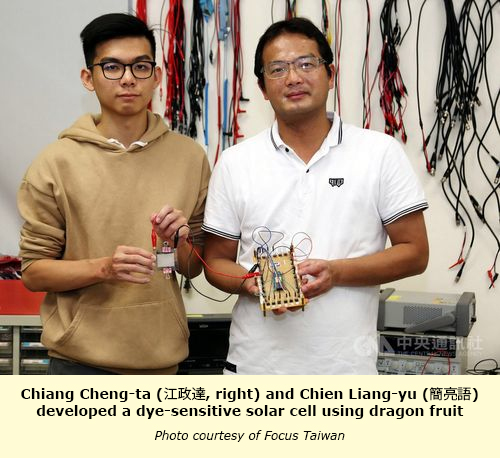A student and his professor at National Chiayi University have developed a method of using a natural dye extracted from dragon fruit, or pitaya, in the fabrication of dye-sensitized solar cells (DSSCs).
The proposed pollution-free, low-cost technique has been published in the Feb. 4 edition of the Institute of Electrical and Electronic Engineers Sensors Journal.

Traditional silicon solar cells or thin-film solar cells must be made in a dust-free environment and the manufacturing procedures are cumbersome and constrained by the specific environmental requirements and high-cost manufacturing equipment, said Chiang Cheng-ta (江政達), a professor of electrical engineering who co-authored the research report with his student, Chien Liang-yu (簡亮語).
In comparison, one of the most attractive features of DSSCs is their low production cost, Chiang said, adding that DSSCs can also be fabricated and assembled in a non-vacuum environment at regular room temperature.
Manufacturing of DSSCs is simple and is mainly fabricated using synthetic dyes, with only a few cases in which vegetables and fruits are used as dye sources, Chiang said.
Synthetic dyes can be used as sensitizers for DSSCs but they can cause pollution, he added.
Therefore, to reduce pollution, natural dyes extracted from fruit containing blue-colored anthocyanins, such as blueberries, pomegranates, cranberries and pitaya can be used as alternative materials for DSSCs, he said.
Pitaya was used as the main source of natural dye in the study conducted by Chiang and Chien.
It took two years to conduct the study on the development of the organic-based DSSC and the utilization of natural dyes is a new area for study due to their unique capability to absorb photons from natural sunlight or artificial light and convert it into electric current.
The purpose of the study was to determine the potential of natural dye from red dragon fruit waste as a dye sensitizer, according to Chiang.
For his part, Chien, a senior at the university, said he floated the idea of conducting the study as Taiwan is facing a potential power shortage as it moves toward phasing nuclear energy.
